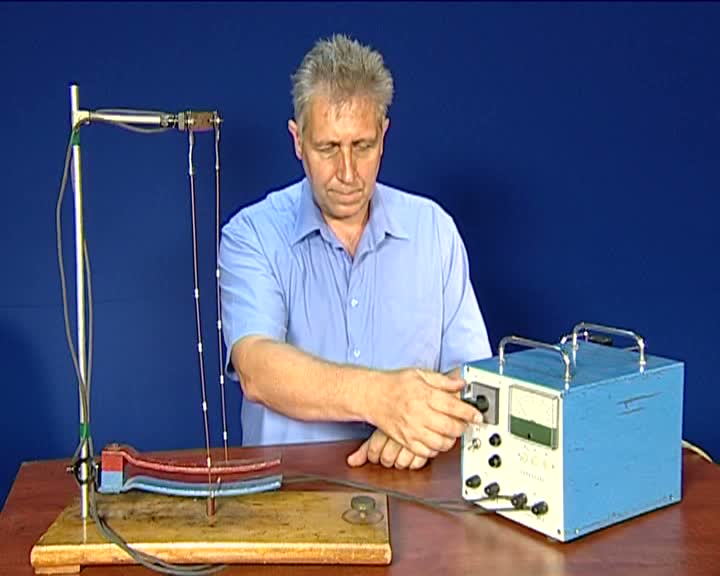„Mágneses tér erőhatása árammal átjárt vezetőre” változatai közötti eltérés
| 24. sor: | 24. sor: | ||
A mágnesek kialakításából és a vezető felfüggesztéséből látszik, hogy a mágneses indukcióra merőleges az áramirány. Az áram bekapcsolása után a mágneses indukció erővel hat a vezetőre, amelynek hatására az lengésbe jön. Az áram kikapcsolása után egy egyszerű gravitációs ingamozgást látunk. Ugyanolyan nagyságú, ellentétes irányú áram indításával vízszintesen ellentétes irányban játszódik le az előbbi mozgás. | A mágnesek kialakításából és a vezető felfüggesztéséből látszik, hogy a mágneses indukcióra merőleges az áramirány. Az áram bekapcsolása után a mágneses indukció erővel hat a vezetőre, amelynek hatására az lengésbe jön. Az áram kikapcsolása után egy egyszerű gravitációs ingamozgást látunk. Ugyanolyan nagyságú, ellentétes irányú áram indításával vízszintesen ellentétes irányban játszódik le az előbbi mozgás. | ||
| − | = Interaction between bar magnet and current loop | + | == Interaction between bar magnet and current loop == |
| − | + | ||
| − | + | ||
One can see from the arrangement of the magnets and the suspension of the conductor that the direction of the current is perpendicular to the direction of the magnetic induction. After switching on the current the magnetic induction exerts force on the conductor which will start swinging. By switching off the current one can see a simple gravitational pendulum motion. With a same magnitude but an opposite direction current the same motion will result but in opposite direction. | One can see from the arrangement of the magnets and the suspension of the conductor that the direction of the current is perpendicular to the direction of the magnetic induction. After switching on the current the magnetic induction exerts force on the conductor which will start swinging. By switching off the current one can see a simple gravitational pendulum motion. With a same magnitude but an opposite direction current the same motion will result but in opposite direction. | ||
</wikitex> | </wikitex> | ||
A lap 2013. április 18., 15:33-kori változata
Az I árammal átjárt dl infinitezimális vezetékdarabra B indukciójú térben
dF = Idl x B
erő hat.
Ennek az erőhatásnak következményét láthatjuk a kísérletben.
v sebességgel mozgó q töltére B mágneses indukciójú térben
F = q v x B
erő hat. Ez a Lorentz erő, amiből következik a mozgó töltések alkotta áramra ható erő fenti kifejezése.
Kísérleti elrendezés
A jelenség bemutatásához nagy áramerősség körülbelül 30-100 Amper erősségű áram szükséges. Ezért a bemutatás során a vezeték jelentősen melegedhet, esetleg látványosan füstölhet is.
Az elhangzó szöveg
A mágnesek kialakításából és a vezető felfüggesztéséből látszik, hogy a mágneses indukcióra merőleges az áramirány. Az áram bekapcsolása után a mágneses indukció erővel hat a vezetőre, amelynek hatására az lengésbe jön. Az áram kikapcsolása után egy egyszerű gravitációs ingamozgást látunk. Ugyanolyan nagyságú, ellentétes irányú áram indításával vízszintesen ellentétes irányban játszódik le az előbbi mozgás.
Interaction between bar magnet and current loop
One can see from the arrangement of the magnets and the suspension of the conductor that the direction of the current is perpendicular to the direction of the magnetic induction. After switching on the current the magnetic induction exerts force on the conductor which will start swinging. By switching off the current one can see a simple gravitational pendulum motion. With a same magnitude but an opposite direction current the same motion will result but in opposite direction.
